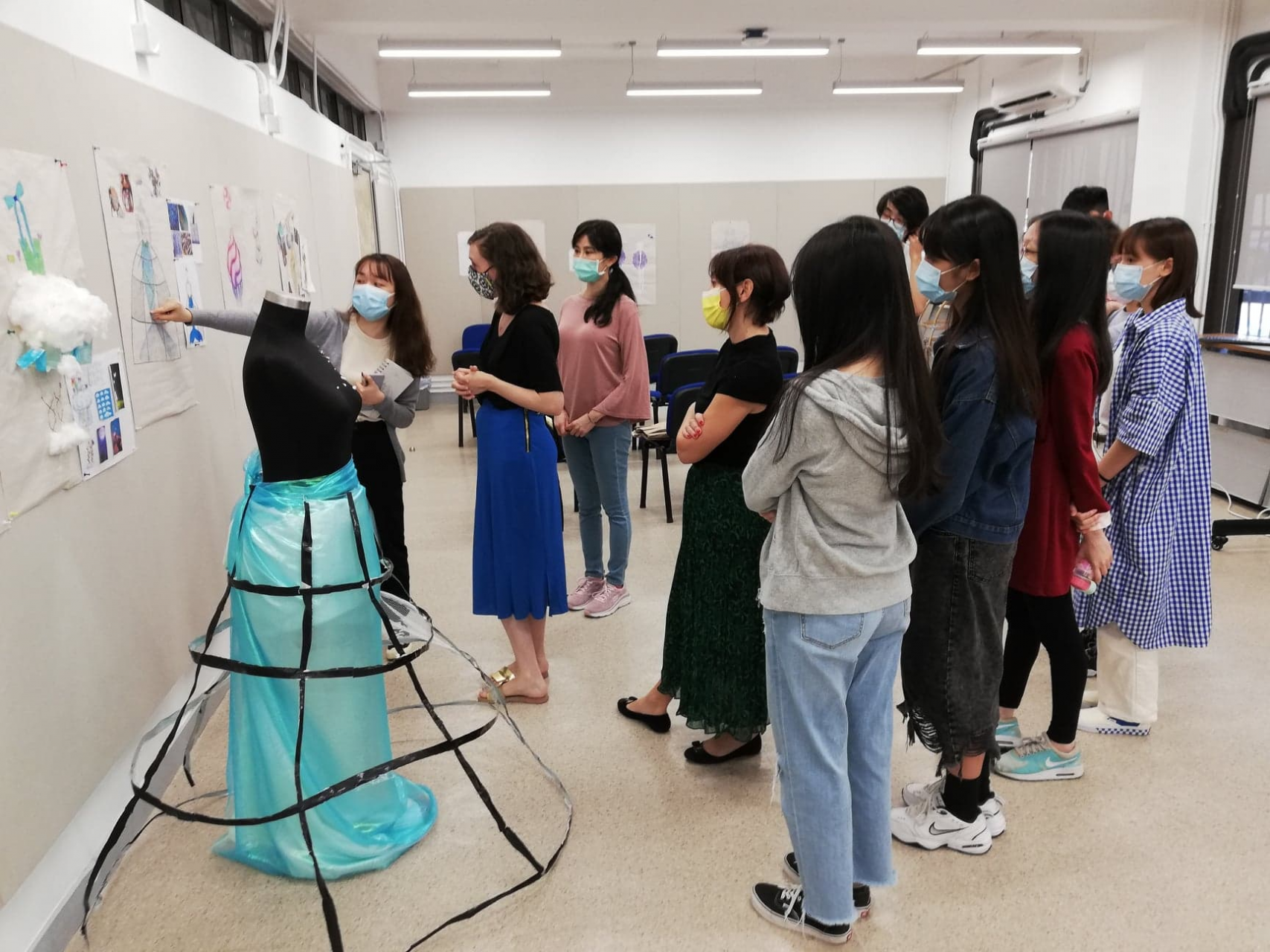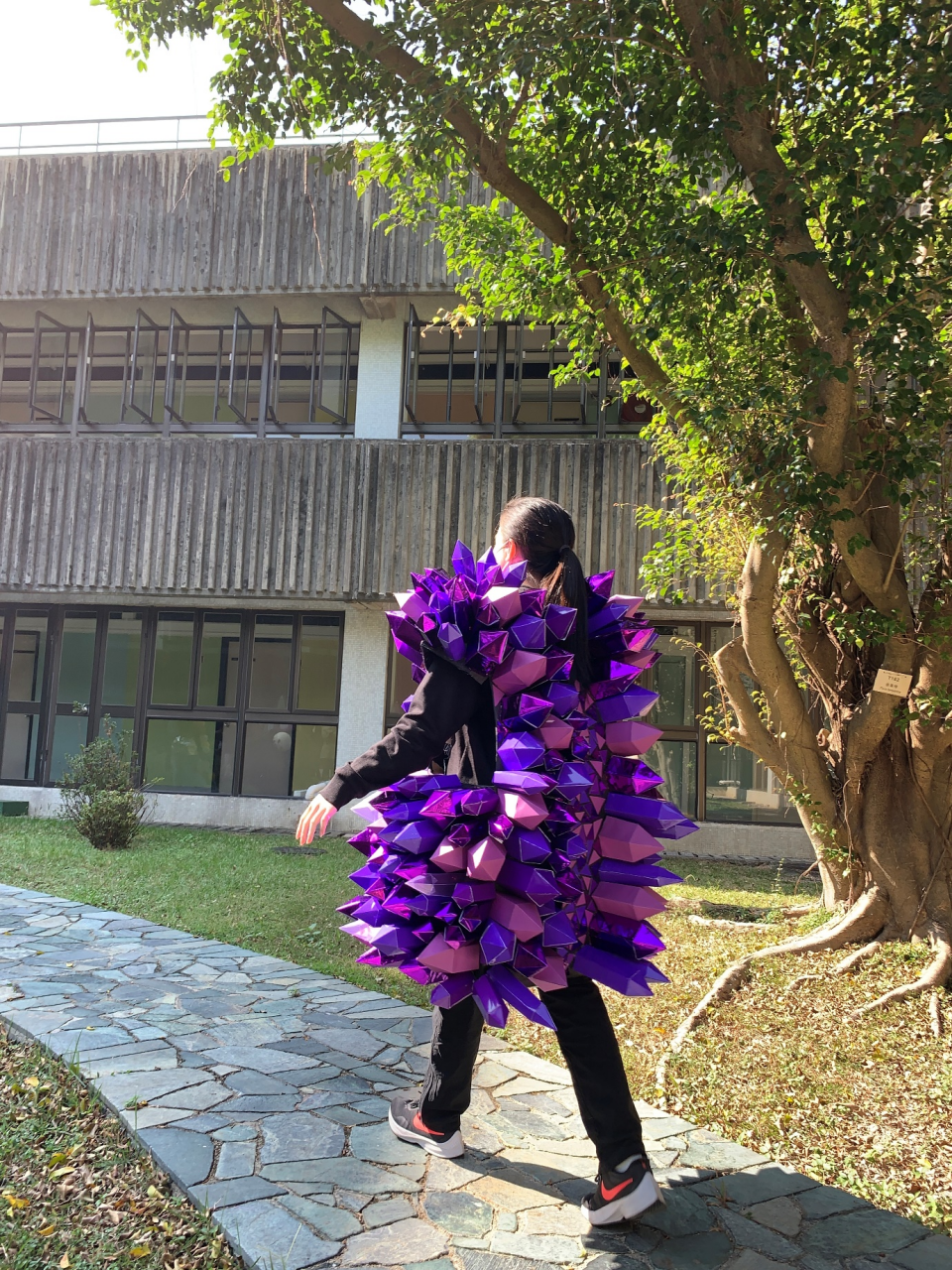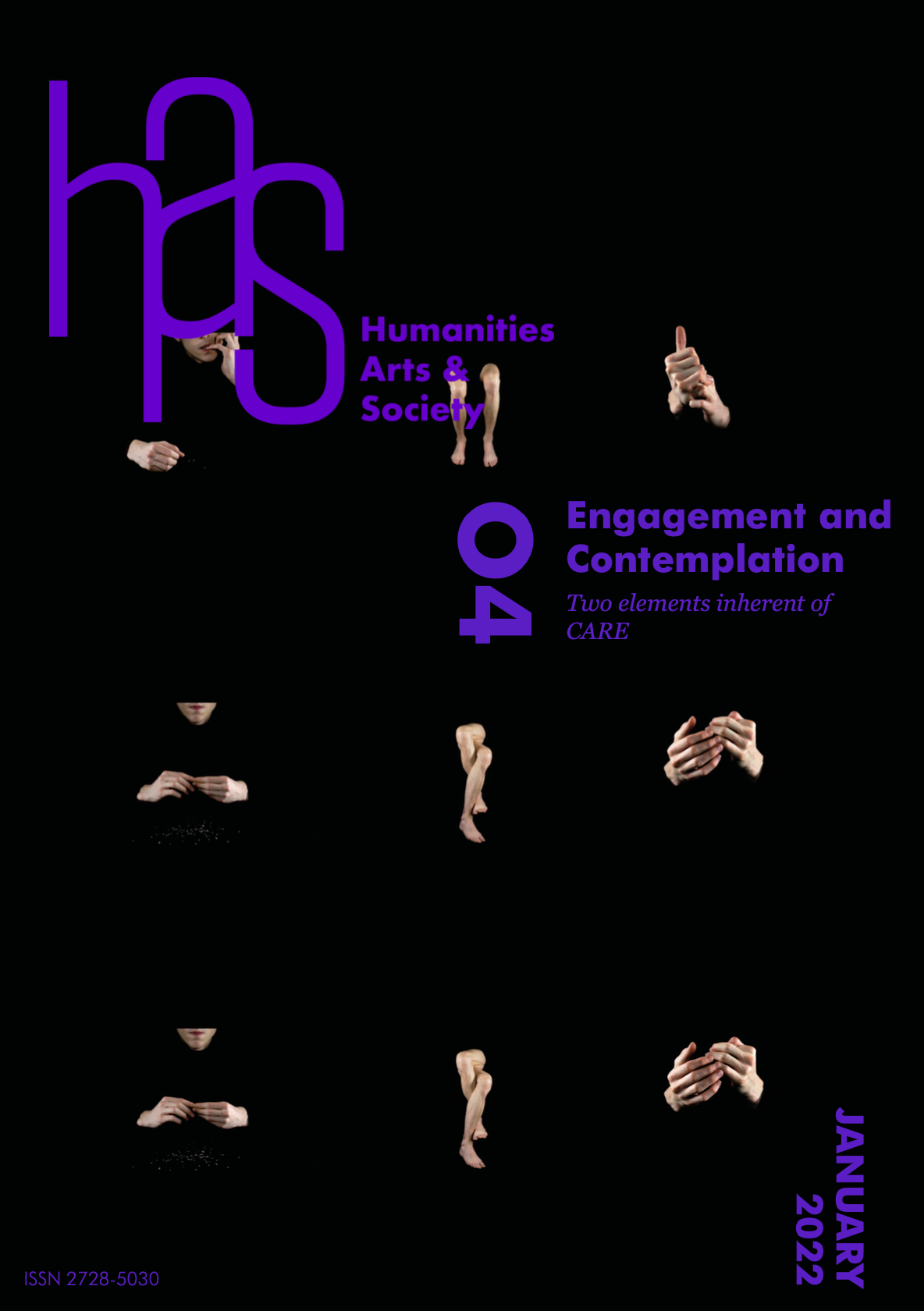
This paper introduces the concepts of the Art And Design Studio for the BA in Art And Design, founded in September 2020 at the Hang Seng University Of Hong Kong.1 A series of project assignments were conceived after Italo Calvino’s Invisible Cities. Students were asked to interpret the text of a chosen city in terms of urban design and city planning, public space, and furniture design, with the end-of-term production of a piece of wearable art.
The project continued with a second term of digital design, starting with a city logo, a product brand with a shopfront window display, and finally a video promotion of the city.2 Because the project was conducted during the pandemic lockdown, students were challenged to create their projects according to their vision of a post-pandemic society and world.
This paper will discuss some of the representative projects in terms of the theme of Engagement And Contemplation to illustrate how the idea of care is inherent to the design of the Calvino city—one which may stand for many of the real cities that we inhabit, with our own expectations for a new and common future.
Engagement and contemplation in art and design
Art and design engage with the audience, whether visually or—in a more contemporary sense—immersively.3 Engagement is a result of contemplation; hence, to understand the relationship between engagement and contemplation in art and design, one must analyze them first as contemplative acts. The meaning of contemplation with respect to art and design goes back to the original Latin root of the word—i.e., acting to delineate and interpret an augury in the temple (con- templum; contemplatus or contemplari). Therefore, contemplation is rooted within the spatial origin of a sanctuary or temple or, more macroscopically, a community or city. One may even argue that it is only within a city or community context that engagement, as a result of contemplation, is possible. The contextualization of contemplation and engagement allows artists and designers to fully understand these acts, which ultimately leads to the idea of care in their projects.
In the following sections, I will present how this contextualization of contemplation and engagement is systematically articulated through the four sub-themes of transformation in the Art And Design studio assignments within two semesters of the academic year 2020-21.

From literary to visual and immersive
As contemplation implies the spatial context of a city and community, the act of design as contemplation naturally starts within such a context. We have therefore chosen a famous text depicting imaginary cities along the travel routes between East and West—Italo Calvino’s Invisible Cities (1971), inspired by the legendary travels of Marco Polo as literary narratives presented to Kublai Khan. Each instructor chose a city for their group of students to work on, and each student was asked to come up with a plan of the city based upon their reading.4 This transformative contemplation—from literary to visual interpretation—is the key to all subsequent exercises for the design studio as students were asked to elaborate the design of the main urban spaces of their cities. The spatial sequences of movements and events, interpreted from Calvino’s stories and descriptions provided the conceptual framework of the design, which required that students imagine experiences from the macro-perspective of a bird’s-eye view to a more tactile and immersive environment. This marked the first transition for students to contemplate.
From macroscopic to bodily inhabitation
The imaginative journey from city to urban space was further refined when students were asked to inhabit their spaces with the design of a piece of urban furniture—a bench for sitting and relaxation. For this contemplative exercise, students had to first engage with their own bodily form and structure, and had to measure their body parts and produce an appropriate drawing, similar to the diagrams from Renaissance masters such as Leonardo da Vinci and Cesare Cesariano. The inspirations for their bench designs would have to observe, not only the objective and contextual environment of urban spaces, but also the students’ subjective interpretations of their own bodily ergonomics, as well as the overriding interpretation of the city according to the literary text. The transformative contemplation, from city to urban space to object of inhabitation, therefore represents three different levels of engagement. The bodily engagement culminated with the final exercise of the first semester, in which students were required to design a piece of wearable art unique to their city. This experience ended with students wearing their artwork for a catwalk show at the end of the semester.






Fig. 7: Drawings of the Wearable Art Project for the City of Dorothea by CHUI Hoi Ting, Daisy. (Photo credit: Desmond Hui)


From tangible to digital
The second semester continued this contemplative journey of invisible cities5 in the digital realm, with the training of students on the necessary use of software such as Adobe Premiere. The pedagogic structure of the semester was divided into four projects. The first was to design a brand and logo for the invisible city, which resulted mostly in 2D representational graphics. The differentiation from tangible designs to digital representations was accompanied by a corresponding shift of engagement from the physical and spatial needs of the cities to a more conceptual and spiritual level. This was followed by the next task, that of designing an object or product that gave the city its unique brand. However, as the contemplative process was limited to the digital realm, students were not required to physically produce their objects or products, and the connection between the city brand and logo with the product/object remained visual and semiotic.





From iconic to symbolic
The third exercise in the digital exploration of Semester 2 was to come up with a shopfront design as product display for the city brand. Similar to the shift in Semester 1 from object to space, the challenge for students was to provide a spatial setting for an iconic object of their design that paralleled a shift from icon to symbol. Students needed to translate the meaning of their created object from its likeness to its ability to evoke ideas. This process of abstraction, as well as the manifestation between symbols and icons, had already been tackled in the last assignment of Semester 1, that of creating a piece of wearable art—the clothing of the body with symbolic objects rather than the iconic representation of real dress and materials. The process of city brand design, from the lofty association of lifestyle ideas to the tactile articulation of corporeal adornment, was thus complete.
The last assignment in Semester 2 was a summary transition from icon to symbol. The comprehensive conclusion of the students’ propositions for their invisible cities was to produce a multi-media video as a brand promotion for the city. The video also served as a documentary, piecing together the previous design projects with a coherent vision and a statement of the student’s unique way of interpreting the city from the text.6
Vision of the post-pandemic world
The final exercise required students to not only present their readings and interpretations of their invisible cities, but to situate them within the grim reality of the pandemic-struck society—literally borrowed from Hong Kong and other cities students knew through the media. For this last exercise, we conducted several joint online classes with staff and students from the Department Of Architecture And Industrial Design at the University Of Compania Luigi Vanvitelli in Naples, Italy.7 Without explicit demand from the project brief, all students were naturally able to reflect how their own projects would become acts of hope and care for the city and community, thus realizing a deeper meaning of art and design beyond their utilitarian and even symbolic functions.8

NOTE: All IP picture credits have been cleared with authors.
References
1I would like to acknowledge and give credit to the staff and students of the Department of Art and Design at HSU, especially my studio co-teachers, Dr. Rochelle Yang and Ms. Laura Cavanna, and our technician Mr. Samson Wong.
2Documentation of the works from Semester 2 can be viewed at https://aad.hsu.edu.hk/zh/fundamental-concepts-and-skills-online-exhibition-of-student-works/
3The immersive trend in art and design further emphasizes the theme of engagement and contemplation and is linked to a broader cultural trend witnessed in marketing, entertainment, and social media. Cfr. Special Issue of Art in America, Jan/Feb 2021. https://www.artnews.com/art-in-america/features/immersive-art-1234580701/.
4The 3 cities chosen for Semester 1 were Diomira, Dorothea and Valdrada.
5The cities chosen for Semester 2 were Baucis, Irene, and Sophronia.
6Some examples of video projects for the city of Baucis: https://youtu.be/ArTPOOAW-r4; https://www.youtube.com/watch?v=IXEMU6CHxEE; https://www.youtube.com/watch?v=bkdAIoXO8yQ. for the city of Sophronia: https://www.youtube.com/watch?v=pF0Z5fHwP2U; for the city of Irene: https://www.youtube.com/watch?v=N4IURCnJH7Y&t=6s
7In this connection, I would like to acknowledge the staff and students from Italy, especially Professor Sabina Martusciello, Francesca Muzzillo, and Carla Langella.
8https://youtu.be/ArTPOOAW-r4 For this video animation, the student worked with the city of Baucis and his final statement as expression of hope and care for the city was “With smile, nothing will separate.”
Professor Desmond Hui is Professor and Head of Department of Art and Design at The Hang Seng University of Hong Kong. A registered architect in both Hong Kong and Canada, he has held Visiting, Honorary and Adjunct Professorship in Mainland China and Hong Kong. Formerly, he was Associate Dean of Arts and Professor at the Chinese University of Hong Kong. He taught architecture previously at the University of Hong Kong and was Director of the Centre for Cultural Policy Research at HKU. He has served on various international advisory committees including Expert Advisor to UNESCO and British Council on cultural and creative industries and is member of the International Committee of Architectural Critics (CICA). He is Chief Author and Editor of several government / public studies related to arts and cultural policy in Hong Kong including the Baseline Study on HK’s Creative Industries (2003), A Study on Creativity Index (2005), Study on the Relationship between the Pearl River Delta and Hong Kong’s Creative Industries (2006) and Mapping Study of Creative Clusters in Hong Kong (2010 & 2015). He was selected as Lead Curator for the 11th International Architecture Exhibition of Venice Biennale Hong Kong Pavilion in 2008 and Co-Curator in 2012.
Professor Desmond Hui is Professor and Head of Department of Art and Design at The Hang Seng University of Hong Kong. A registered architect in both Hong Kong and Canada, he has held Visiting, Honorary and Adjunct Professorship in Mainland China and Hong Kong. Formerly, he was Associate Dean of Arts and Professor at the Chinese University of Hong Kong. He taught architecture previously at the University of Hong Kong and was Director of the Centre for Cultural Policy Research at HKU. He has served on various international advisory committees including Expert Advisor to UNESCO and British Council on cultural and creative industries and is member of the International Committee of Architectural Critics (CICA). He is Chief Author and Editor of several government / public studies related to arts and cultural policy in Hong Kong including the Baseline Study on HK’s Creative Industries (2003), A Study on Creativity Index (2005), Study on the Relationship between the Pearl River Delta and Hong Kong’s Creative Industries (2006) and Mapping Study of Creative Clusters in Hong Kong (2010 & 2015). He was selected as Lead Curator for the 11th International Architecture Exhibition of Venice Biennale Hong Kong Pavilion in 2008 and Co-Curator in 2012.
